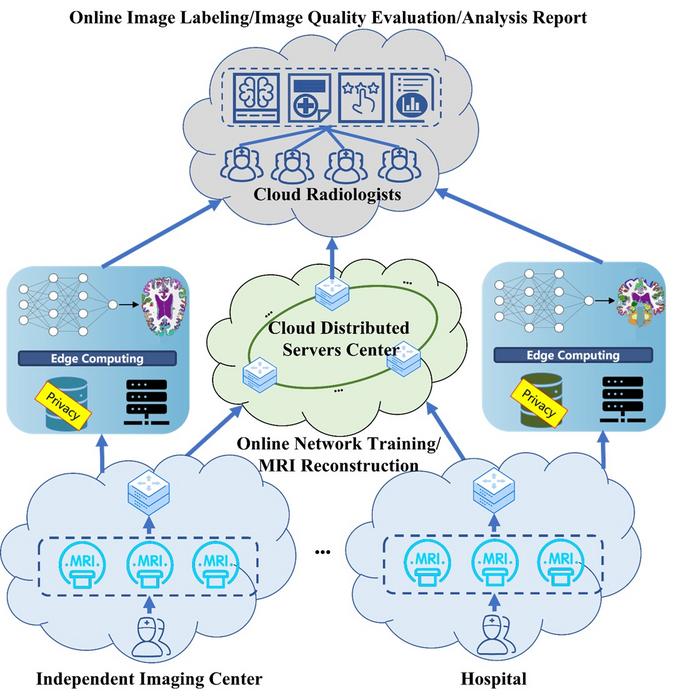Cloud-MRI: Revolutionising medical imaging in the 6G and AI era
Researchers at Xiamen University have developed a groundbreaking Cloud-MRI system that promises to transform medical diagnostics by harnessing advanced technologies such as 6G, AI, and distributed computing.

The workflow of the Cloud-MRI System
In a significant leap forward for medical imaging technology, researchers at Xiamen University – in a paper published in Magnetic Resonance Letters [1] – have unveiled a revolutionary Cloud-MRI system that aims to address longstanding challenges in MRI data management and utilisation. The innovative platform, developed by Professor Xiaobo Qu and his team, leverages cutting-edge technologies including distributed cloud computing, ultra-fast 6G bandwidth, edge computing, federated learning, and blockchain to enhance data sharing and improve diagnostic capabilities across healthcare institutions globally.
Overcoming traditional limitations
Magnetic Resonance Imaging (MRI) has long been a cornerstone of modern medical diagnosis, generating petabytes of crucial data annually across healthcare facilities worldwide. However, the field has grappled with significant challenges in big data storage, accessibility, and security, hindering its potential to further enhance global healthcare.
Prof. Qu explains: “Traditional methods of managing MRI data face significant limitations, from storage constraints to barriers in collaborative research. Our Cloud-MRI system will address these challenges by harnessing the power of distributed cloud computing, ultra-fast 6G bandwidth, edge computing, federated learning, and blockchain technology.”
A new era of data management
At the heart of the Cloud-MRI system is its ability to upload k-space raw data, which is essential for MRI reconstruction, to unified servers or local edge nodes in the ISMRMRD format. This standardised, vendor-neutral file format facilitates rapid image reconstruction and enables advanced artificial intelligence (AI)-driven tasks, significantly enhancing diagnostic efficiency.
The system’s architecture comprises four main components: the data transmission layer, the data processing layer, the distribution tasks layer, and a system monitoring module. This comprehensive approach ensures seamless data flow from raw acquisition to diagnostic reporting, all while maintaining robust security and privacy measures.
Enhancing speed and efficiency
One of the most striking advantages of the Cloud-MRI system is its potential to dramatically improve data transmission speeds and reduce costs. By leveraging 6G technology, the system can achieve transmission rates up to 1 TB/s, more than 3.4 times faster than current 5G networks. This not only accelerates the data transfer process but also enables synchronous scanning and transfer, potentially reducing annual fees by up to 35%.
Advanced image reconstruction and analysis
The Cloud-MRI system incorporates state-of-the-art image reconstruction algorithms, including compressed sensing and deep learning reconstruction techniques. These advanced methods enhance image quality by reconstructing images from sparse data using neural networks, potentially improving diagnostic accuracy and efficiency.
Prof. Qu’s team has already demonstrated the system’s capabilities in reconstructing diffusion-weighted images (DWI) and T2 fluid-attenuated inversion recovery (FLAIR) images from brain tumour subjects, showcasing its potential in clinical applications.
Collaborative and secure AI training
The system also facilitates collaborative AI training between hospitals through federated learning tools. This approach allows for the improvement of AI algorithms without the need to share sensitive raw data, thus protecting patient privacy while advancing medical imaging technology.
A roadmap for the future
The researchers have outlined an ambitious development route for the Cloud-MRI system, spanning four generations of technological evolution. The first generation, which has already been deployed in some settings, focuses on lab or radiology department-level infrastructure. Future generations aim to expand the system’s capabilities to cover healthcare alliances and eventually all healthcare institutions, incorporating advanced features such as high-resolution multi-nuclear metabolic quantitative information and even nanoscale abnormality detection.
Prof Qu emphasises: “We anticipate successful Cloud-MRI system will lead to transformative impacts on medical diagnostics and patient care.”
Challenges and considerations
While the potential of the Cloud-MRI system is immense, the researchers acknowledge several challenges that must be addressed as the technology evolves. These include the need for continuous performance enhancement, feature augmentation, integration of new technologies, ensuring robust data security and privacy, and refining the user experience.
As the medical imaging community looks towards a future of more efficient, collaborative, and advanced diagnostic capabilities, the Cloud-MRI system represents a significant step forward in realising the full potential of MRI technology in the era of 6G and artificial intelligence.
Reference:
- Zhou, Y., Wu, Y., Su, Y., Li, J., Cai, J., You, Y., Zhou, J., Guo, D., & Qu, X. (2024). Cloud-magnetic resonance imaging system: In the era of 6G and artificial intelligence. Magnetic Resonance Letters, 200138. https://doi.org/10.1016/j.mrl.2024.200138

